| Release List | Coupons | Shop | Reviews | SUBSCRIBE | Forum | Video Games | Price Search | Advertise |
| DVD & MOVIE REVIEWS |
|
|
| DVD TALK FORUM |
| REVIEWS & COLUMNS |
|
• DVD Reviews • Theatrical Reviews • Video Game Reviews • Adult DVD Reviews • DVD Interviews • The Aisle View • The Blue Room • Cinema Gotham • CineSchlock-O-Rama • DVD Savant
|
| SHOP |
|
• Adult DVD Empire • Amazon.com (DVD) • Buy.com • DeepDiscountCD • DeepDiscountDVD • DVD Empire • DVD Overnight • DVD Planet • Ebay • Half.com • HKFlix.com • HTMarket.com • Complete List of Stores |
| DVD RESOURCE |
|
• DVD Talk Forum • DVD Price Search • Store Ratings • Customer Service #'s • DVD FAQ • Regional Encoding Info • Search Toolbar • Links |
| DVDTALK INFO |
|
• About DVD Talk • Advertise • Contribute • Tell A Friend • Newsletter Subscribe • Join DVD Talk Forum |
 |
Major Dundee |
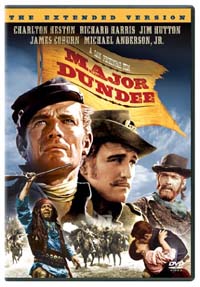
|
Major Dundee, The Extended Version Sony DVD 1965 / Color / 2:35 anamorphic 16:9 / 135 123 min. / Street Date September 20, 2005 / 19.94 Starring Charlton Heston, Richard Harris, James Coburn, Senta Berger, Jim Hutton, Michael Anderson Jr., Brock Peters, Warren Oates, Ben Johnson, Slim Pickens, R.G. Armstrong, Dub Taylor, Michael Pate, Karl Swenson, Begonia Palacios, Aurora Clavell |
Cinematography Sam Leavitt, Art Direction Al Ybarra
Second Unit Director Cliff Lyons
Film Editors William A. Lyon, Don Starling, Howard Kunin
Original Music Christopher Caliendo (2005) Daniele Amfitheatrof (1965)
Written by Oscar Saul, Harry Julian Fink & Sam Peckinpah
Produced by Jerry Bresler
Directed by Sam Peckinpah
Savant has already reviewed this show once as a theatrical offering; besides thoroughly assessing the DVD quality and extras, I'll use this additional space to go into more detail on the picture. As regular readers here might already know, it's this writer's favorite movie. This 'review' is really an essay and should probably have 'For Peckinpah Fanatics Only' as a sub-heading.
Why get so excited about Major Dundee when there are so many more accomplished movies out there? It's a question with several answers. My interest in the picture was sort of a bounce-back effect from being so ga-ga over The Wild Bunch for five solid years 1969 through 1974 or so. Jim Kitses' book Horizons West and the class I was able to take with him at UCLA convinced me that Sam Peckinpah was the contemporary filmmaker that 'put it all together for me,' a promise that none of his films post- Bunch fulfilled. But looking back at Major Dundee with an editor's eyes, trying to figure out what the missing material hinted at in Kitses' book might be, became a recurrent obsession. Remember, this was in the early 70s when the 'long' version of The Wild Bunch we all know now was for me only a few remarks from teaching assistant Janey Place; it wasn't until that epochal Beverly Canon screening in 1974 that I finally got to see both Peckinpah and his personal uncut print of Bunch.
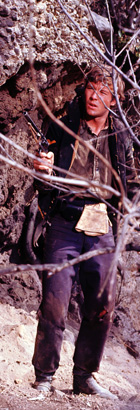
The more I studied Major Dundee, the more I felt that it was an even more meaningful picture. The Wild Bunch was a soured and bitter liberal look at groups of men engaged in crooked fighting at the periphery of a war; it coincided with the inescapable conclusion that Vietnam was a political quagmire. Major Dundee came out right as the Vietnam conflict began to escalate and has a cynical but not entirely hopeless attitude toward foreign adventurism.
I obtained an original shooting script in 1979 that laid out exactly what Peckinpah planned to film as he started his fateful production already fighting an uphill battle against his producer and his studio. That's when the enthusiasm clicked in, as the information in the script illuminated aspects of Peckinpah's intentions that even Kitses had not been able to consider. 1
The script, coupled with two day's reading of Peckinpah's special collection papers on Dundee at the Academy library (at the recommendation of fellow Peckinpah researcher Darren Gross) told me several 'secrets' about the film, the kind that make one feel in possession of privileged information:
1) The movie was never more than 2/3 written; it desperately needed another draft to make sense of the last act and resolve all the issues raised in the first act. Peckinpah's story dissolves as we lose track of the Indians in the picture -- the editors repeat a medium shot of Sierra Charriba just to remind us who he is. The French are also poorly established and never seem to be engaged until the final battle. Senta Berger's Teresa is hustled in and out of the movie, giving us the feeling of huge missing sections, even with the reinstated Extended Version material.
2) Told to make an epic like Lawrence of Arabia, the hired writers (and perhaps Peckinpah as well) literally grafted situations from previous epics into the picture. For instance, Dundee's exile in Durango is lifted wholesale from Lawrence, and the shooting of O.W. Hadley (Warren Oates) is a plain steal from both Lawrence (Lawrence shoots a murderer to keep his tribal allies from killing each other) and The Guns of Navarone (Irene Papas shoots traitor Gia Scala because nobody else has the guts required to kill a woman).
3) The rest of the film is a huge collection of homages to earlier Westerns, and not just John Ford cavalry pictures. As in The Wild Bunch most of the borrowings invert the spirit of the originals: The troop has no solidarity (the conflicting songs as they ride out from Fort Benlin) and the rules of war are mocked ("The Major ain't no lawyer, sonny - You now got four minutes"). The 'holy mission' is a fraud, as retrieving the kidnapped children is an excuse and not a goal. Peckinpah borrows John Ford's songs and repeats the burial scene from The Searchers.
4) Peckinpah's lack of big-time production experience really screwed up the movie. Roaming hundreds of miles all over Mexico with a troupe bigger than the Ringling Brothers Circus wasted a huge portion of the budget. Some locations are extremely effective but many are almost generic and could have been done 100 miles from Los Angeles in the Mojave desert. Even more galling is the fact that in many shots actors stand or sit on horses in front of an empty sky: they could have been filmed in a parking lot back in the studio.
5) The movie is not visually distinguished. In Lucien Ballard Peckinpah had found a cameraman who transformed every setup into visual art. Probably out of frustration with his director, Sam Leavitt seems happy just to get a shot. The many day-for-night scenes look terrible (and in this new transfer seem to have been printed extra dark). The interior art direction both on location and in the Churubusco studio is pretty sad as well. There are many terrific shots, but a lot of the film looks like indifferent coverage.
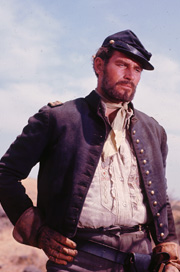
6) (A personal theory). Peckinpah's intention was to criticize the character of Dundee, not exalt him. Dundee represents what Peckinpah thinks is the chaotic side of American military ambition. Determined to regain face and be a great officer, Amos invents a personal war to take the place of opportunities he'll never be given by his own army. He exceeds his authority as soon as he patrols the territory, as that is not the function of a prison-keeper. Losing all those troops at the Rostes Ranch surely means the end of his career. But Amos is so set on his personal destiny that he defies all authority to launch a spectacular campaign for personal gain, robbing his own army to obtain weapons and hiring a thief to procure needed horses. In a missing scene probably not filmed, Dundee's underling Captain Waller (Karl Swenson) tries to arrest him as he crosses the Rio Grande into Mexico.
I believe that Peckinpah intended for Charlton Heston to play an Oliver North kind of character, without even telling him. Heston provided the faultless performance of a dedicated soldier, and Peckinpah's plan was to subvert the character into a war criminal behind Heston's back, in much the same way that William Wyler and Gore Vidal pulled the wool over Heston's eyes and made his Ben-Hur bisexual.
7) If Peckinpah had an ounce of political finesse he could have won Columbia and perhaps even his producer Jerry Bresler over to his way of thinking. No, 1963 was the dawn of the concept of the Director as Star and Peckinpah was determined to rocket to the level of the Antonionis and David Leans by sheer will. What he should have earned on Dundee he decided he already had. The studio (and its new penny-pinching head Mike Frankovich) opted to squash the arrogant director early on. It was quickly Columbia versus Sam Peckinpah, to the extent that assistant director John Veitch 'rode herd' on the wayward director for the front office. Peckinpah never fully picked up on the studio's potential for vindictiveness; in the cheapskate post-production dubbing, Sgt. Gomez (Mario Adorf) is made to report to Dundee on the guard clubbed by Richard Harris by saying "Corporal Vietch just died, Sir." (at 11:25)
8) If Bresler and Peckinpah ever saw eye to eye, any understanding between them dissolved as filming progressed slowly and dailies seemed unimpressive. Bresler's correspondence asserts almost from the start that Peckinpah's 'obscene' gory details will not be allowed in the movie. Peckinpah's courtly letters angle to retain things he's shot, like an unscripted moment where Bugler Ryan dips a ladle into a river after a battle and comes up with a dipper full of blood (this would immediately follow the action at 1:01:01 - 1:01:48).
Bresler appears to have methodically removed all of Peckinpah's graphic violence, and would have excised the buckets of blood in the river battles if it were possible to do so. His stated excuse was that as producer it was his picture, and he wanted a cut that would not be bounced back by censors either in America or overseas. He mentioned that his greatest successes, the Gidget movies, made money for Columbia because they were censor-proof.
Look at the movie again. When the suicide Apache tries to assassinate Dundee at the Rostes Ranch
(5:36) the final cut makes it look as if both Sam Potts (James Coburn) and Dundee were meant to fire their
shotguns at him, point blank. Look closely at the minimized angle on the Apache and you'll see a
bit of a massive squib effect, two years before Bonnie & Clyde. In the first river battle
a rider falls on a hillside and his horse starts to roll over on him, but the camera cuts away (57:27).
Bresler probably made the cut just to irritate Peckinpah, because the featurette Riding for a Fall
continues the action to show the painful-looking stunt in toto.
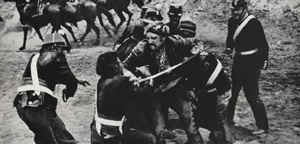 The last shot in the
Super-8 color
version of the featurette demonstrates that Peckinpah intended the death of Captain Tyreen (Richard Harris)
to be a much more drawn out affair. Tyreen isn't lanced in the saddle but de-horsed and run through as he
regains his feet. Photos in the disc's still section bear this out; Tyreen's dying grimace is
revealed to take place when he is standing, not sitting on his horse.
The last shot in the
Super-8 color
version of the featurette demonstrates that Peckinpah intended the death of Captain Tyreen (Richard Harris)
to be a much more drawn out affair. Tyreen isn't lanced in the saddle but de-horsed and run through as he
regains his feet. Photos in the disc's still section bear this out; Tyreen's dying grimace is
revealed to take place when he is standing, not sitting on his horse.
9) There is no slow motion in the final cut, and it is altogether likely that Peckinpah never got the opportunity to experiment with the thousands of feet he shot of multi-camera slow motion battle footage. Remember that he was able to spend at least five months cutting The Wild Bunch but on Dundee was locked out of the studio editing room after only a few rushed weeks, just long enough to get an assembly together. That's what Dundee is, a partially tuned assembly of the movie with about a half-hour to forty minutes' worth of material missing. Many scenes -- the baiting of trooper Aesop (Brock Peters), the 'trial' of O.W Hadley -- are either chaotically cut or desperately in need of trimming.
The disc commentary refers to two shots immediately following the ambush of the Apache as slow motion, which they are not. A short shot of Dundee at the top of the ravine (2:04:11) is step-printed (each frame printed twice), probably to turn a fragment of film into a useable shot. The shot of Sierra Charriba's body being pushed to the bottom of the ravine (2:04:22) isn't slo-mo either, but simply filmed using a narrow camera shutter that takes the blur off the falling body and makes it 'chatter' down the incline. The same narrow shutter effect can be seen as Dundee and Sgt. Gomez descend from the prison roof (26:54). The narrower the shutter, the less blurred motion becomes, like action photography made with a strobe light. No slow motion footage made it into the cut of Major Dundee.
10) Bugler Ryan's narration wasn't invented in post-production. It was always in the script, meant only as an ironic comment on the action. It showed how one immature soldier might see the campaign, an effect put to notable use in real letters read by actors in Ken Burns' television documentary The Civil War. In post-production, some of Ryan's lines were changed or added to plug holes in the script.
In all fairness, Peckinpah doesn't satisfactorily tell his story. His visuals ignore many seemingly crucial events, like the return of the Rostes boys. The narration only points out the lapses in continuity and audiences usually pay little attention to narration in movies anyway. Why aren't we being told useful things instead of idle observations? Where are the Indians? Where are the French? Where did the forward momentum of the story go?
In this writer's opinion, Peckinpah never framed a proper ending for his film. The opening narration says that Ryan's journal provided 'the only surviving record of the massacre and the campaign that followed.' Are we to understand then that Dundee's decimated troop never gets back to Fort Benlin, and that Dundee never announces his historic success? Or that Captain Waller or General Carlton didn't keep records of the massacre of eighty troopers and the disappearance of fifty more men into Mexico? Even if Peckinpah wanted to leave his tale with Teresa's prediction that 'for Dundee, the war will never end,' the conclusion seems arbitrary. Even the script's coda, with Potts and Dundee finding yet another mocking Apache marker in their path, might not have been enough.
Sony Pictures DVD of Major Dundee: The Extended Version will certainly thrill Peckinpah fans with its bright picture and plentiful extras - the picture now plays better than it ever has. The feature was remastered on film, with the additional eleven minutes of 'new' footage recovered from a perfect set of color separations made just before the show was chopped down for the last time in 1965. Old flaws from mis-timed printing elements are gone, and both color and image definition have improved. The day-for night scenes are purposely timed darker than ever before, so don't try and watch the film at high noon in a bright room. The encoding is good but not terrific; as with last month's The High and the Mighty, the main titles 'buzz' with pixel artifacts.
The disc is encoded with two separate soundtracks, the original 1965 Daniele Amfitheatrof score and Christopher Caliendo's moody 2005 re-score for the Extended Edition theatrical release. The new score is in 5.1; the video seamlessly branches to accomodate different title sequences. Viewers who know Dundee will welcome the opportunity to watch it without being distracted by the old music track, which fights the movie all the way. Amfitheatrof's main theme is good but over-used and other musical choices (the romance theme, for one) are just terrible. Mainly, the old score just refuses to go away - even quiet dialogue scenes are dominated by insistent, inappropriate cues. And there's always the idiotic musical sting to complain about ... (push the button):
Christopher Caliendo's score improves the movie by staying mostly in the background. He has a good marching theme and his mariachi re-score for the Mexican fiesta is far superior. Allowed to play without underscoring, key dialogue scenes are now twice as effective.
This writer believes that one reason the old Dundee had so much music was to allow producer Bresler to finish the film without the expense of a full audio job. When the music tracks are playing loudly, there's no need to fill dialogue with presences or add simple things like wind noise and background walla. One of the few drawbacks of the new score is that the audio-scape often goes dead whenever the music stops. Big scenes are thin on the effects track, even battle scenes. The troop charges out of the river at a full gallop, yet we barely hear them.
There are a wealth of extras to discuss! The 'Peckinpah Historians' on the commentary track are the same group of noted Peckinpah biographers previously heard on discs for Bring Me the Head of Alfredo Garcia and The Osterman Weekend: Nick Redman, Paul Seydor, Garner Simmons and David Weddle. They really know their specialty and fill the track with interesting ideas and opinions, especially when it comes to understanding the point of view of the director. Over a year ago, Warner DVD planned a multi-disc boxed set of Peckinpah westerns featuring new transfers of titles from their library -- The Wild Bunch, The Ballad of Cable Hogue, Pat Garrett and Billy the Kid and Ride the High Country. I've seen an amazingly good new HD transfer of Ride and am eager to see the same with The Wild Bunch. The original plan was for Warners to 'borrow' Columbia/Sony's Major Dundee as it had done with Dr. Strangelove for its Stanley Kubrick boxed set back in 2000. The group did the commentary for Dundee after the restoration but before the new music score was initiated, and before the loan-out to Warners fell through (the last Savant heard, the Warners box might come early in 2006). This accounts for the old score being used behind the commentary and the authors' allusion to several Peckinpah DVDs, not just one.
The group spends a lot of time saying what's wrong with Dundee and accounting for the apparent incompetence behind the final release version. This makes for a curiously negative track, as most of the authors think that the film is Peckinpah's worst. Scene specific comments tend to be generalizations and nobody quotes the script to clear up story inconsistencies. They get many observations exactly right, especially the curious formlessness of the final reels. But they tend to fall back on the Moby Dick-Red River argument to explain the Dundee character.
Dundee is no Ahab. He's not driven and obsessed, but calculating and ambitious. He doesn't really give a hoot about rescuing children or even killing Sierra Charriba. What Dundee wants is a career and glory. He's a moral cripple (as symbolized by by his leg wound) who doesn't know how to inspire loyalty from his men and instead uses the power of his rank to dominate them. That's the definition of a martinet, and Captain Tyreen's natural charisma and leadership ability repeatedly reveal Dundee for what he is.
When Jimmy Lee Benteen (John Davis Chandler) tells Aesop to remove his boots 'like a good nigger', the command almost falls apart on the spot. One of the commentators has the idea that Dundee is purposely staying silent to force Captain Tyreen to take charge. I don't believe that Dundee is in control of anything, or that he has the faintest clue what to do (besides keep the green Lt. Graham out of harm's way). Amos just sits there like a lump, while it finally dawns on him that half the men he's brought to Mexico would gladly cut his throat. Tyreen's inspired action shows the flair and flexibility Dundee lacks: Tyreen gives a condescending but formally acceptable compliment to Aesop, diplomatically defusing the situation. That Tyreen can perform such a subtle gesture while essentially being Dundee's involuntary prisoner, is another proof of Dundee's inferiority.
Another 'major' extra are raw clips and a couple of partially-edited sequences of missing scenes. All were discovered by Sony VP Grover Crisp in boxes left over from an exhibitor's promo touting upcoming 1965 Columbia product. The biggest chunk is part of the never-before-seen fiesta knife fight between Sam Potts and Sgt. Gomez. The original release cut of Dundee had no night-for-night exteriors at all, and Crisp's extended cut adds a few seconds of fireworks and partying that show, among other things, a drunken and unhappy Potts being snubbed by a village girl (1:18:45). The extra clip is the beginning of a cut scene intended to follow. It could not be reinstated into the film because a) it was probably re-cut to work as a promo, and b) stock music library cues mixed into the track don't match anything in Dundee.
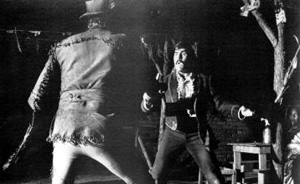
If the knife scene were intact, it would further explain Amos Dundee's inadequacy as a leader of men. Potts is a rough mountain man and this is his character-defining scene. Bitter and mean, he provokes a fight with young Armando for his girl, who he insults by calling a 'she-cat.' Gomez steps in and fights in Armando's place, but the contest immediately changes from a dangerous death match into a macho ritual for its own sake. The clip ends as Dundee arrives to break up the fight, hitting Potts' arm with his Navy Colt pistol.
But in the script the scene continues. Both Potts and Gomez tell Dundee to mind his own damn business, as he understands nothing of what is going on. Before Potts and Gomez can charge each other again, Tyreen faces off with Potts. Potts laughs and throws his knife down. When Dundee leaves, Potts, Gomez, Tyreen and Armando are arm in arm, drinking like happy idiots. Dundee is once again proven the outsider.
What strikes Savant about the fight scene excerpt and the raw outtakes is how ordinary Peckinpah's blocking is. The angles used are just standard uninteresting coverage.
Two other 'raw, uncut takes' reveal more about the film. As both shots appear in shortened form in the remnants of the promo cut (obviously the basis for the original trailer), the raw takes were retained because they were sorted out as optical material to be duped but not cut. One shot is the full unedited master take of Dundee ordering the gallop to the river, the one where the shadow of Sam Leavitt's camera crane is discernable against the lines of mounted horsemen. In his diary accounts of the shoot Heston often mentions his own superior horsemanship and that of his troopers, and what we see is better than anything in a John Ford Western. Dundee calls attention and the horses snap into line like soldiers on parade. Heston rides out to confer with his scouts, and then rides back and reverses his mount into position like he's parallel-parking a Volkswagen. One forward-ho later, The entire troop starts out as a unit without a single horse going astray. The uncut take allows us to see that most of the troopers are the real actors, not pro wranglers or Mexican cavalrymen.
The first outtake is the real prize, as it's probably the mastershot for the intended first scene of the legendary missing opening of the movie. The troop of soldiers -- who will later be massacred by Sierra Charriba's Indians -- rides into frame, moves through some sheep herders and heads for the Rostes Ranch. In the script, cowboys and 'wooly wardens' exchange light insults. Peckinpah possibly intended this loose shot to have some credits over it, although the script reserved the main title for where it appears now, after Charriba delivers his oath: "Who will you send against me now?"
2The first rider in the column is Lt. Brannin, who in the final film is only seen hung upside down over a fire, wounded, burned and incoherent. According to Academy records he's played by Jody McCrea, son of star Joel McCrea of Ride the High Country. Brannin prances by, the prima donna of Dundee's young Lieutenants. He wears a dashing white scarf, indicating possibly that he models himself after the stylish George Armstrong Custer. At any rate, he's drawn the exciting job of hunting Charriba instead of pulling boring duty back at Fort Benlin.
Several horses back, the Scout Riago (José Carlos Ruiz) rides manacled and under arrest. Brannin has found nothing and has already decided to save face by scapegoating Riago - he intends to hang him when they get back to the fort. Peckinpah was in the Marines, and knew how efficiently any army's chain of command reassigns the blame for failure ... and Riago is an Apache, after all.
3The other promo outtakes are mostly scraps, the most useless being the textless artwork for the original American posters, some of the ugliest stuff ever done. Sony's DVD box illustration is by contrast a really great Photoshop construction - the best ad images for the film since the original French poster.
An especially good feature is an augmented excerpt about Dundee from Mike Siegel's docu Passion & Poetry - The Ballad of Sam Peckinpah. Good interviews cover the production of the movie from a fair perspective. Senta Berger talks about Peckinpah in German and the show even addresses Peckinpah's rash marriage to Begonia Palacios, the Mexican actress who played Linda, Tim Ryan's girlfriend. The only off-note comes from Peckinpah stock company actor L.Q. Jones, who tells a far-fetched Peckinpah story. After hearing Jones' gonzo commentary on the disc of his A Boy and His Dog, I'd take anything he said with a grain of salt.
Major Dundee's official featurette Riding for a Fall is presented in B&W 16mm (Savant's print) and in color Super-8, a slightly different cut. The short has many instances of publicity B.S., especially when it implies that its step-framed action shots of stunts are real slow motion. If only it were so.
That old publicity ignorance extends to the present, and the new theatrical trailer and the text on the back of the
DVD. They come from the same handouts that accompanied the theatrical release last April. Working
totally against the spirit of the restoration, the trailer and publicity copy make one false claim
after another. Dundee was not the first film taken from Peckinpah and re-cut, that was his
The Deadly Companions. 'Most of the missing footage' has not been found, and the film is not
a 'restored masterpiece' -- it's easily twenty
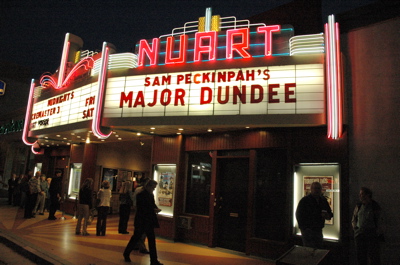 or thirty minutes short of what Peckinpah screened
earlier. Nobody can say what he would have ended up with because he never got the chance to
finish the film. The film never raises the issue that Dundee's men might be a greater threat than
the Apaches - the tagline is meaningless. The pub copy asserts that Major Dundee is 'at last
presented as its legendary director intended,' which is sheer nonsense.
or thirty minutes short of what Peckinpah screened
earlier. Nobody can say what he would have ended up with because he never got the chance to
finish the film. The film never raises the issue that Dundee's men might be a greater threat than
the Apaches - the tagline is meaningless. The pub copy asserts that Major Dundee is 'at last
presented as its legendary director intended,' which is sheer nonsense.
The end of the trailer beckons us to 'Fall in with the Major', a tagline that refers to the lyrics of Mitch Miller's chorus march. Getting rid of that silly song was a big part of the motivation for Sony to commit to creating a new Extended Version with a new music score. Curiously, the trailer contains no new footage from the film!
The film's clunky but colorful original 1965 trailer is included as well. The ID closeup of Tyreen shows him fingering a feather in his hatband, from a deleted scene. The script has Tyreen shoot a bird to obtain the feather as a cavalier's decoration. Not much later, Peckinpah has Tyreen tear the feather on a desert tree branch, and moodily regard it. (37:25) After O.W. Hadley is shot, Tyreen symbolically plucks the feather out and drops it to the ground (1:38:44). Savant didn't notice the detail until he'd seen the film uncounted numbers of times.
Savant was invited to write the liner notes for the disc and aimed to summarize the complex filming of the movie and present an accurate account of the 2005 restoration-rescoring. I think the notes are positive addition, if only because the disc would otherwise address the whys and hows of the new Extended Version only through Sony's misleading publicity copy.
There's a lot more to be said about Major Dundee, and I realize that the cumulative effect of the comments above might make the film seem a disorganized mess. It's far better than that. It's a great picture with many brilliant scenes and powerful moments. If mangled movies by great filmmakers were studied as closely as lost books by great authors, I believe Dundee would stand out as an American national epic about the politics of military adventurism.
On a scale of Excellent, Good, Fair, and Poor,
Major Dundee rates:
Movie: Excellent
Video: Excellent
Sound: Excellent
Supplements: Two soundtracks; 20-minute extended excerpt from Mike Siegel's
documentary Passion & Poetry - The Ballad of Sam Peckinpah; commentary by Peckinpah authors
Nick Redman, Paul Seydor, Garner Simmons and David Weddle; two versions of the stunt featurette
Riding for a Fall; clips, fragments and raw takes from a 1965 exhibitor's promo, including
remnants of two still-missing scenes; a selection of rare stills; two trailers
Packaging: Keep case
Reviewed: August 19, 2005
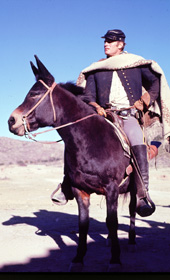 Footnotes:
Footnotes:
1. Even
the noted Peckinpah biographers who share an interview on this disc (they're affectionately known
as the 'Peckinpah Posse') could do with a re-reading of the script. At one point they wonder
why Amos Dundee is stuck riding a mule when other soldiers have horses. The script (and earlier
treatments) establish that Dundee considers himself a fancier of mules and thinks they make better
mounts than horses. He rides one to prove himself a superior trooper and to raise morale. The
joke comes with the irony that, after all his praise of mules, this one refuses to cooperate
and won't budge.
Return
2. By the way, look at the shot of the stand of trees, followed by
Dundee's troop making their entrance at the Rostes ranch (feature: 3:21 - 3:28). These shots once
formed a jump cut when Dundee was only available as a Pan-Scan video. The script only
partially backs up this theory, but Savant thinks it possible that both cuts were originally opposite ends of
one uncut take, a slow trucking shot down the row of trees, finally ending
on the gap where Dundee and the spearhead of his column climb the hill to the foreground.
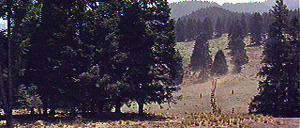 I theorize
that Peckinpah intended the trees to serve as a background for the balance
of the main titles.
I theorize
that Peckinpah intended the trees to serve as a background for the balance
of the main titles.
Return
3. By the way, the commentators say that the opening massacre scenes
were at least partially shot and filmed last in the production schedule; they venture the possibility that
they were of poor quality and that one reason the sequence was cut is that it didn't work. This
writer believes otherwise. The excellent opening for the film, with Dundee's troop surrounding the
massacre scene, was filmed at the same time. If the footage was of indifferent quality, it would
still have to 'stand in line' behind several other sequences that play like blah second-unit
efforts. Dundee researcher Darren Gross has interview
testimony (that Savant is not at liberty to present here) that everything was shot, right down
to the slaughter of the Rostes family and their Halloween guests the Romeros and Cartwrights.
Return
DVD Classics Corner Radio has a web interview show, DVD Classics Corner Radio presents Michael Anderson Jr. and Christopher Caliendo on MAJOR DUNDEE.
|
|
| Coming Soon |
|
|
| Special Offers |
|
|
| Columns |
| Home | Release List | Coupons | Shop | Reviews | Forum | Video Games | Price Search | Advertise |





